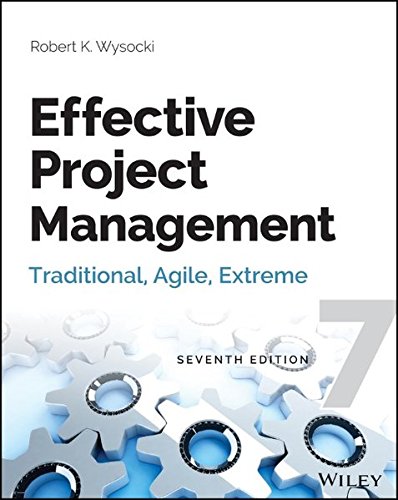
The popular guide to the project management body of knowledge, now fully updated Now in its seventh edition, this comprehensive guide to project management has long been considered the standard for both professionals and academics. With more than 32,000 copies sold in the last three editions, it has now been fully updated to cover the new PMBOK 5. Well-known expert Robert Wysocki has added more than 100 pages of new content based on instructor feedback, enhancing the coverage of best-of-breed methods and tools for ensuring project management success. With enriched case studies, accompanying exercises and solutions on the companion website, and PowerPoint slides for all figures and tables, the book is ideal for instructors and students as well as active project managers. Serves as a comprehensive guide to project management for both educators and project management professionals Completely updated to cover the new PMBOK 5 Examines traditional, agile, and extreme project management tech
More
 Agile Project Management: A Quick Start Beginner’s Guide To Mastering Agile Project Management
Agile Project Management: A Quick Start Beginner’s Guide To Mastering Agile Project ManagementDiscover Agile Project Management *** 3rd Edition *** DO YOU WANT TO ACHIEVE THE BEST AT EVERY STAGE OF A PROJECT ? DO YOU …
 Project Management in Practice
Project Management in PracticeThe updated 6th Edition of Project Management in Practice provides streamlined coverage with an applied approach, focusing on…


Great book about project management,
I like very much how he understands the application of the acronym IRACIS (Increase Revenue, Avoid Costs, Improve Services) for the choice of the whole set of requirements for a project and how to decide the type of project to follow according with these features.
Slides are available too, and they are a very useful tool as a support to my classes
Congratulations for this book!
Was this review helpful to you?

|An Excellent Practical Introduction to the Changing Methodologies in Project Management,
Perhaps because of this, project management books seem to be generally grouped into one of two buckets: strong in either traditional project management or in agile project management. Additionally, many of the traditional project management books are narrowly directed towards content needed for preparation for the PMP® professional certification exam. But what about readers who are seeking a good practical overview of the practice of project management, including how the different approaches relate to each other and how a practitioner might choose one over the other in particular circumstances? This is where Dr. Wysocki’s book shines. Note: my review is based on the most recent seventh edition of the book.
I came across this book while making a selection for project management texts for a graduate business course I was going to teach. I wanted a text that captured the current dynamic thinking in project management by providing a foundation in the traditional processes while explaining the emerging tools beyond the traditional methodologies. The subtitle of this book says it all: “Traditional, Agile, Extreme.”
I actually selected this text to use in my course before this seventh edition was even published. Having reviewed the sixth edition, I correctly assumed that the seventh addition would reflect even more contemporary thinking. I was not disappointed.
The book has 18 chapters organized into five parts:
Part I: Understanding the Project Management Landscape (context for the remainder of the book);
Part II: Traditional Project Management (the scope, plan, launch, monitor and control, and close process groups);
Part III: Complex Project Management (agile, extreme, as well as iterative and adaptive approaches);
Part IV: Managing the Realities of Projects (reducing risk, organizing teams, process improvement, and other topics); and
Part V: End State – Maturing to an Enterprise-Level Project Management Model (enterprise level issues).
Although there is some redundancy between chapters, the book does an excellent job of showing the range of methodologies and processes available in the project management toolkit. Examples are provided on how to use various analysis, tracking and reporting tools and related worksheets. The author spends time looking at the enterprise level of project management too – managing project portfolios, continuous improvement of processes across organizations, and the capture and transfer of learning. If you are considering this book for an academic classroom or for workshops or seminars, the author is extremely accessible and he provides supplemental materials on the book’s website.
The strength of this book is in providing a practical project management overview on how the traditional, agile and extreme methodologies both overlap and differ at the same time. I would not recommend this book as a primary study aid for PMP certification; it does not focus on the cut and dry terminology used in PMI’s Project Management Book of Knowledge (PMBOK) for example (it does follow the same process groups, however). Simply, that is not the purpose of this book.
Wysocki’s Effective Project Management (7th ed) does an excellent job of introducing the wide scope of considerations, techniques and choices that are deployed in the continuously changing world of project management today while doing what few other project management books offer – explaining that project management is not about deploying a static, one-size-fits-all approach or process; it is about choosing what techniques best fit the demands of the specific project to make it successful.
My recommendation: buy this book if you are interested in an excellent overview of project management in its most contemporary forms.
Was this review helpful to you?

|